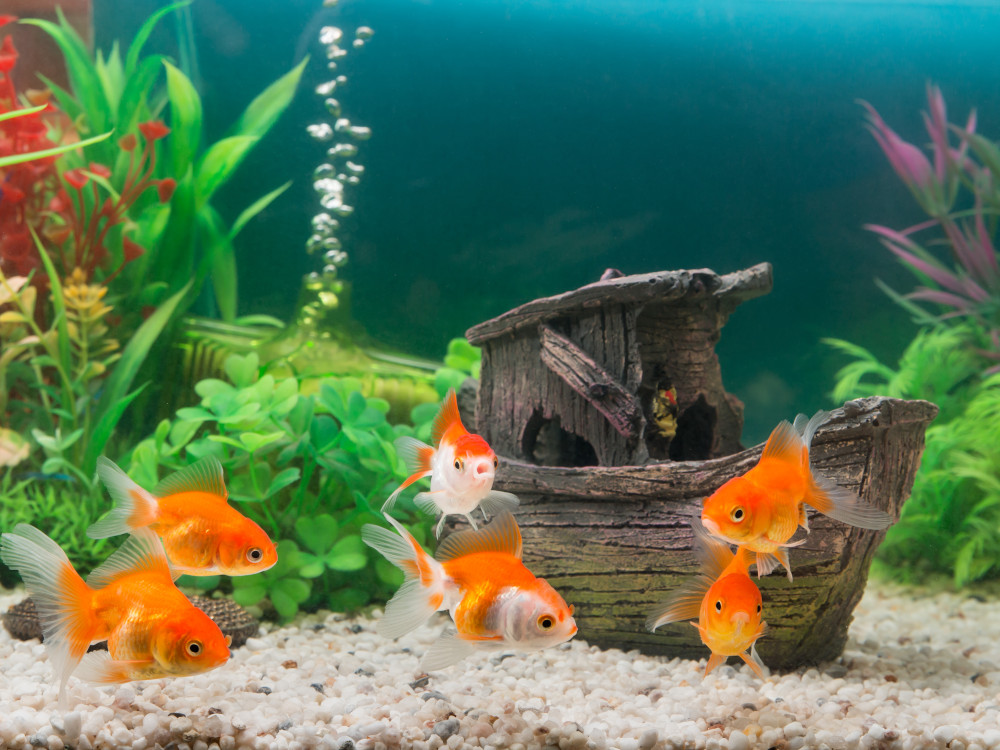
Goldfish (Carassius auratus) are the most popular of all aquarium fish and are known for their attractive bright colours. Goldfish originate from temperate climates and in the wild they live in cool streams, lakes, and ponds throughout Asia. Today, there are a wide variety of goldfish types available.
Goldfish are social and intelligent animals and are regularly seen interacting with each other and their human caregivers, whom they can learn to recognise. Goldfish have a lifespan averaging about 10 to 15 years, with some varieties living up to 30 years when provided with proper care. Unfortunately, many goldfish do not reach their lifespan potential due to inadequate care. Housing needs to meet both their physical and mental needs. The following information will help to improve goldfish longevity, health, and welfare.
Purchasing a healthy goldfish
When purchasing a goldfish first check that the seller is reputable and that their aquariums are not overcrowded. Purchasing from a large aquarium store will generally be a good option. Healthy fish display clear and bright body colouration, and they hold their fins erect. Healthy fish are also alert and swim without undue effort.
Indicators of poor health include fish that sink or bob to the surface; fish that have lumps, bumps, wounds, clamped fins, or a trail of excreta (faeces) and fish that stay in a corner of the aquarium for a prolonged period of time.
Aquarium size
You will need to consider how large your fish will be when they reach adult size and the total number of fish you wish to keep. Certain types of goldfish may have increased space requirements, such as slimmer goldfish that are usually more active meaning these varieties need a larger and longer aquarium, than generally recommended for their body size.
The larger the tank and filter (see below), the better it is for your goldfish. The minimum tank volume should be 50 litres and with the following tank dimensions:
- Length minimum of 4 times adult body length
- Width minimum of 2 times adult body length
- Height minimum of 3 times adult body length
The more the fish you have, the larger your tank will need to be.
Traditional fish bowls are too small for goldfish and should be avoided. There are many brands of aquariums that incorporate filtration and lighting which can be good alternatives. Regardless of the shape, all tanks should have a covered area/side where the fish are not exposed to bare glass. This promotes better welfare for your goldfish, as they will be less stressed and feel more secure.
Water quality
Good water quality is essential for any aquarium and is the key to ensuring your goldfish remain healthy. Regularly test your water for ammonia, nitrite, and nitrate levels to ensure your biological filtration is working, you are maintaining it appropriately and your aquarium is not overstocked or over fed.
Refer to article Why is water quality important when setting up a fish aquarium?
Other water parameters to monitor include pH and water temperature.
Ideal water parameters for goldfish are:
- Ammonia < 0.1 ppm
- Nitrite < 0.2 ppm
- Nitrate < 50 ppm
- pH 6.5 to 7.5
- Temperature 20 to 24°C
When starting a new aquarium, until the Nitrogen Cycle is established, test the water every two to three days for ammonia and nitrite for the first six weeks. After this testing every one to two weeks is sufficient.
Further information and videos are available at Aquarium Care 101 (Aquarium School / The Aquarium Vet).
Filtration and aeration
Goldfish are heavy feeders and high waste producers that require efficient filtration of a suitable size to maintain water quality and for aeration. Good filtration will ensure all water is regularly filtered mechanically and biologically via the nitrifying bacteria in the filter media. If the filter does not create bubbles or stir the surface water, aeration with an air stone is needed to ensure that the water is well oxygenated.
When selecting a filter, ensure the water current is adjustable. The current should not be too strong, especially if fancy or unusual goldfish types are to be kept as fast currents can make swimming difficult for some of these fish.
Tank maintenance
Weekly partial water changes of 10 to 25% of the tank water are recommended combined with a gravel clean to remove waste and to help your goldfish remain healthy.
A gravel siphon purchased from a pet store should be used. Gently shake the siphon briefly in the aquarium to start the flow of water into a bucket below. Use a dedicated (labelled) fish bucket which will not be used for other purposes to avoid any harmful chemical residues. The end of the siphon in the tank can be used to clean the gravel by vacuuming the substrate to remove fish faeces and any uneaten food. Fish can stay in the aquarium while siphoning to minimise stress, though care should be taken not to move too rapidly as this may stress the fish.
NEVER suck on the hose to start a siphon as this can cause human health issues.
After 10 to 25% of the water is drained, replace the water with cold tap water. It is worth having a second bucket that was filled the day before with tap water. This allows some of the chlorine to gas off and also brings the water temperature up to room temperature. Before adding any new water, it is very important to add the appropriate quantity of an aquarium Water Conditioner (sometimes called water agers) to neutralise the chlorine and chloramine present in the tap water. Carefully read the label of the product that you are using.
Handy Tip – use the old aquarium water on your plants. It is a great fertilizer.
The filter should be rinsed lightly in a bucket of tank water when it starts to get clogged up or on a monthly basis (whichever occurs first). It is important to avoid over-cleaning the filter media as this will remove the beneficial bacteria. Without beneficial bacteria in the filter, ammonia from fish waste will not be broken down to less harmful nitrates, leading to fish death. Do not use tap water to clean the filter, as the chlorine (or chloramines) may also kill the beneficial bacteria.
The inside of aquariums can be cleaned of any algae build-up by wiping the insides gently with a clean, aquarium safe sponge or with a magnetic glass cleaner. Never use soap or detergents when cleaning an aquarium.
Periodically altering the direction of water flow in your aquarium, will also provide some environmental enrichment for your goldfish.
Plants and decor
Goldfish are prey animals and thus require adequate plant cover to prevent stress and facilitate activity. Approximately 50% cover is recommended, with some areas of plants close together and then some open areas of the tank. The more cover provided, the more active your goldfish will become, and plants also provide environmental enrichment.
It has been shown that artificial plants are as effective as real plants from a stress-reduction viewpoint [1]. However live plants have the added benefit of absorbing waste products from the water as well as acting as a source of food for the goldfish. Only source live plants from an aquarium store. Do not collect from the wild as you may introduce parasites or disease into your aquarium. Also only use plastic plants purchased from an aquarium store.
Driftwood and decorations may also provide cover. Ensure that any tank decor is free from sharp or rough edges that may injure your fish or any small holes in which they may become trapped as they grow larger. This is especially relevant for some of the unusual varieties which are generally not strong swimmers and fancy goldfish which may have impaired vision.
Feeding
The most common problem with goldfish is overfeeding, leading to obesity and other health issues. Uneaten food also breaks down and contaminates your aquarium. Feed your goldfish once a day and only what can be eaten in under two minutes. If you have more than one fish, feed in two or more separate areas to make sure all fish eat the food.
A varied diet will maximise the health of your goldfish. A mixture of specialised goldfish flake and granules (small pellets), which contain a high carbohydrate level, is ideal. Make sure that food is stored in a cool place and discard any food not eaten within one year of opening the container.
Fancy goldfish (with shortened bodies) should not be fed flake or floating pellets but rather sinking pellets. This is to avoid them swallowing air while feeding at the water surface. Swallowing excess air causes gas bladder issues, leading to a buoyancy disorder.
Ideally, occasionally supplement this with a mixture of frozen brine shrimp, daphnia, and veggie mix. The diet can also be supplemented by scalded peas. This will offer a varied diet and provide enrichment. Any freeze-dried food should be soaked first to avoid digestive upsets.
Mammalian fats (e.g. from beef heart, meat, offal) are poorly digested in fish, and should not be fed to goldfish.
Limit feeding when water temperatures fall below 8℃ because, being ectothermic (cold-blooded) their metabolism slows at lower temperatures, and they are less able to digest the food.
Lighting
To minimise algae outbreaks, aquariums should ideally be kept away from direct sunlight or windows. Aquarium lights should be left on for a maximum of 10 hours a day.
It is also important that your goldfish have a minimum of eight hours of darkness, so make sure all lights or lamps are turned off at night in the area that your aquarium is located.
Can I house other fish with my goldfish?
Goldfish are social animals and when kept in groups can be seen regularly interacting with each other. Having at least two goldfish in an aquarium will provide companionship and promote activity, which is better for their welfare.
Goldfish are generally not aggressive so they can be kept with most community fish provided the other fish are larger than the size of the goldfish’s mouth. Suitable goldfish tank mates for smaller aquariums may include white cloud mountain minnows, danios, and gold medaka. For variety in larger aquariums, suitable tank mates for goldfish may include Murray River rainbow fish.
Goldfish with extended fins should not be kept with fish that tend to nip fins e.g. tiger barbs (which are tropical fish anyway).
The more unusual goldfish varieties such as the Celestial should be kept with their own variety only as they may find locating and competing for food difficult when housed with other types of fish with superior swimming abilities.
For more information, it is recommended that you talk to an experienced aquarist (fish carer) or fish veterinarian. Goldfish with unusual body types may require specialised care and additional research is recommended for these varieties.
Emergency preparedness
Unfortunately, there is always the possibility that you will need to move or transport your fish in an emergency. This may be because the tank develops a leak or a more serious emergency such as fire or flood. Being prepared for such an emergency is important as transporting your fish safely requires specific equipment and preparation and the survival of your fish can depend on this. For information on preparing an emergency fish transport plan and kit, see this article.
Reference
[1] Sullivan M, Lawrence C, Blache D (2016) Why did the fish cross the tank? Objectively measuring the value of enrichment for captive fish. Appl Anim Behav Sci 174:181–188

